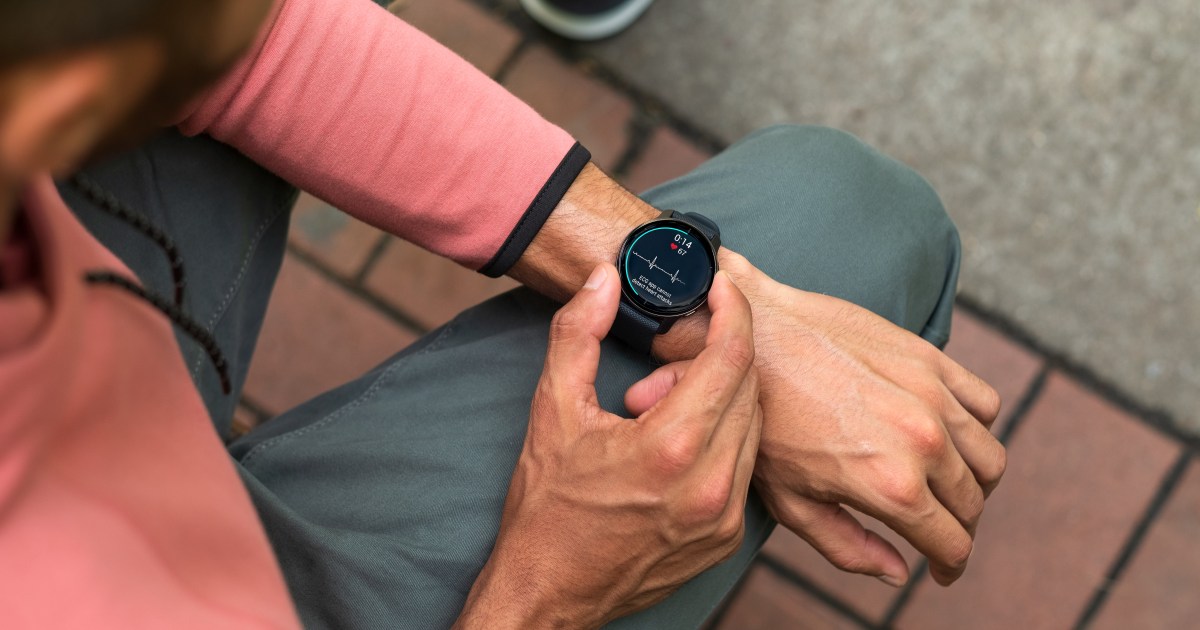A randomized trial of a mobile health intervention to augment cardiac rehabilitation

Overview
The VALENTINE Study is a remotely administered, randomized trial (ClinicalTrials.gov NCT04587882, registration date 10/14/2020)24. Participants in both groups received a smartwatch and usual care in the form of CR. Participants in the intervention group received a comprehensive mHealth intervention designed to augment and extend the benefits of CR. The authors are solely responsible for the design and conduct of this study, all analyses, drafting and editing of the paper, and its final contents. The study was approved by the University of Michigan Health IRB (HUM00162365).
Participants, consent, and enrollment
Enrollment occurred from October 23, 2020 to March 25, 2022, recruiting low and moderate risk patients enrolled in center-based CR as guided by the American Association of Cardiovascular and Pulmonary Rehabilitation criteria25. Eligible patients were 18–74 years old who completed at least two CR sessions at two healthcare systems (University of Michigan Health and Spectrum Health) and spoke English. Patients were required to own either an Android-based phone or Apple iPhone with a study supported operating system. Full inclusion and exclusion criteria are available in Supplementary Table 3. Patients were excluded if they were unable to safely exercise without supervision or had at least one high risk condition (Supplementary Table 4).
All study activities occurred remotely. Participants were guided by study staff through a remote consent process and signed consent forms within the mobile study application MyDataHelps (CareEvolution, LLC). Consented participants were mailed an Apple Watch Series 4 or Fitbit Versa 2 in accordance with smartphone ownership, although they were given the option of using their own smartwatch if compatible. Randomization was performed by study staff using a permuted block design with variable block sizes of 2 to 6 and stratified by smartwatch (Apple Watch or Fitbit) using a random sequence computer-generated program. Neither participants nor study staff were masked to randomization assignment. Following consent, participants underwent a remote enrollment process at which time they were oriented to the mobile study application and assisted by study staff with pairing their devices and configuring their smartwatches to suppress notifications from other health and wellness applications.
Study Ggroups
All participants received a smartwatch for outcome assessments and usual care in the form of CR. Participants were followed for 6-months. The study intervention has previously been described in full24. In brief, the intervention had four components. First, participants received two types of text messages (both one-way text messages): activity messages and exercise planning messages (Supplementary Table 5). Text messages were designed using conceptual behavioral health theories, including goal setting and implementation intentions26,27,28. Activity messages encouraged low level physical activity and incorporated the following contextual information: weather (i.e., temperature, precipitation), time of day (i.e., morning, lunch, afternoon, evening), day of week (i.e., weekend versus weekday), and duration within the study, correlating with phase in CR (ie, initiation [0–30 days], maintenance [31–120 days], completion [121–182 days] phases). Participants had a 25% probability of receiving an activity message at one of four time points each day. Exercise planning messages encouraged participants to exercise the next day within their target heart rate zones and were tailored to the season and duration within the study. Participants had a 50% probability of receiving an exercise message each evening. Exercise planning messages were initially written by CR exercise physiologists with the goal of capturing their voice and extending the human connections developed in center-based CR. Both exercise planning and activity messages could include additional features such as personalization with a participant’s preferred name, loss- or gain-framing, and inclusion of an emoji or hyperlink to the study dashboard. Participants selected the times at which to receive text message times during enrollment visits, with delivery delayed until day 8 of the study, though were allowed to modify selected times during the study if requested.
Participants in the intervention group received three additional components: 1) access to mobile application features that allowed them to engage in activity self-monitoring and goal-setting (Supplementary Fig. 2); 2) a weekly email summary of their smartwatch physical activity data; 3) smartwatch data provided to their exercise physiologists by email and through a web-based dashboard. Participants in the control group had access to either the Apple Health application or the Fitbit application, respectively, and downloaded the study mobile application to enable informed consent, data collection for outcomes assessments, and survey completion; however, it provided no additional functionality. Thus, participants in the control group did not have access to self-monitoring through the mobile application, tailored text messages, or weekly email summaries of their physical activity.
Participants in both groups were followed until study completion or withdrawal or termination by the study team. An independent medical monitor adjudicated all serious adverse events in a blinded manner according to prespecified definitions.
Study outcomes
The primary outcome was change in 6-min walk distance from baseline to 6-months as measured remotely using the mobile study application and smartwatch. 6-minute walk distance was selected as it has prognostic significance in diverse cardiovascular disease populations, improves in response to exercise-based interventions, and can be accurately measured in a remote manner22,29,30,31,32. Participants were given verbal instructions during their enrollment appointments and written instructions in the mobile application on proper completion of the 6-minute walk test, which they then performed independently. For iPhone/Apple Watch and Android/Fitbit users, 6-min walk distance was calculated differently. For iPhone users, during their 6-min walk test, the mobile application triggered their Watch to enter workout mode and, as a result, the Watch recorded the distance walked at more frequent intervals. The mobile application then recorded the start and end timestamps corresponding to 6-minutes and added the distances during the 6-minute interval to determine distance walked. In contrast, for Android users, the Android phone recorded distance walked by using the phone’s Global Positioning System (GPS). Participants were given up to 30-days to complete 6-minute walk tests, but most completed them within 7 days. Distances less than 100 meters were excluded a priori from analyses given invalid data concerns, although the task was reassigned if it was determined to be invalid and within 30-days of its originally assigned date (Supplementary Table 5).
We had two additional secondary outcomes. First, we analyzed the change in mean daily step count between the first 7-days of the study prior to intervention receipt and the final 7-days of the study. For this analysis, participants were required to wear their watches for ≥ 3 days each week to be included in the analysis as at least 3 days of watch wear was felt to be necessary to capture a representative sample of daily activity. We excluded a priori from the analysis days that participants took fewer than 100 steps as they were presumed to have not worn their watches on those days, consistent with recent mHealth studies33. Participants in the intervention group of the study did not receive the intervention until week 2, allowing both groups to have a 1-week baseline period following enrollment (i.e., 175 day intervention period). Second, we evaluated change in 6-min walk distance from baseline to 3-months. Exploratory outcomes included: 1) Change in 6-min walk distance at 6-months adjusted for differences in baseline covariates based on recent guidance from the FDA and others in analyses of randomized controlled trials;34,35,36 2) change in quality-of-life scores over 6-months as measured by the EuroQol visual analog scale (EQ-VAS); and 3) change in mean daily step count between the first 7-days of the study and 3-months (i.e., days 91–97). At the end of the study, participants in the intervention group completed a modified version of the SUS using a 6-point Likert scale to provide quantitative feedback on their experiences interacting with the mobile intervention37.
Statistical analysis
Sample size calculations were based on change in 6-min walk distance at 6-months. The trial was designed to have approximately 80% power to detect a difference between the intervention and control groups irrespective of device type using a 2-sided significance level of 0.05 and change in 6-min walk distance of 50 meters as a change in 6-minute walk distance of 50 meters or less is clinically significant in most disease states13,14. We assumed a baseline 6-min walk distance of 400 meters and a standard deviation of 125 meters. Given a 10% drop-out rate, we planned to enroll 220 participants in total across the two arms.
All analyses were performed as a modified intention-to-treat analysis using data from participants with complete data for either the primary or secondary outcomes, respectively. Baseline clinical characteristics are described as means and standard deviations (SD) for continuous symmetric variables and median with interquartile range for skewed continuous variables. Categorical variables are presented as counts and percentages. We performed student t-tests for bivariate comparisons between continuous variables and Chi-square tests for comparisons across categorical variables. To account for known measurement differences between Fitbit and Apple devices, we performed a regression analysis to jointly test the null hypothesis of no effect between baseline and 6-months for 6-min walk distance (i.e. H0: β0(Fitbit) = β 0 (Apple) = 0 where β0 refers to the estimated coefficients in the model for each device type, respectively). Such a test produces a single p-value inclusive of both device types, although it allows for separate device-specific effect sizes. The decision to do this was to conservatively estimate overall effects of the intervention, and this decision was determined a priori before any statistical analyses were conducted. A subsequent analysis was then performed to determine whether to reject the individual null hypotheses for the devices separately and, if the null hypothesis was rejected, device-specific estimates of statistical significance were determined. Subgroup analyses were performed for the primary outcome based on sex, age < 65 or ≥ 65, heart failure diagnosis, and study site.
Subsequently we performed an exploratory analysis for our primary outcome of change in 6-min walk distance at 6-months that performed an adjustment for differences in baseline covariates. In this analysis, we accounted for baseline covariates of age category ( < 65 or ≥ 65), sex, the presence of heart failure, study site, and baseline 6-min walk distance. As above, we tested the null hypothesis of no effect between baseline and 6-months for 6-minute walk distance. Finally, the SUS was scored using a modified scoring system with each item’s score contribution ranging from 0 to 537. For odd questions, the score contribution was the scale position and for even questions the contribution was 5 minus the scale position. Scores were multiplied by 2 to obtain a measure of overall system usability with scores ranging from 0 to 100. For all analyses, the level of significance was set at p < 0.05.
link







